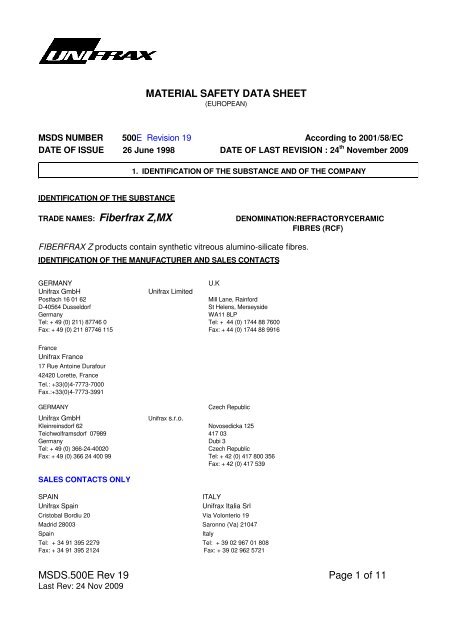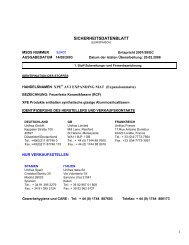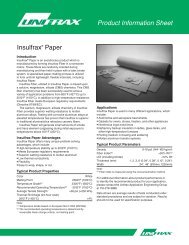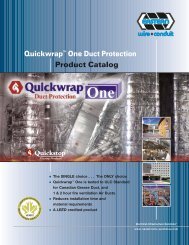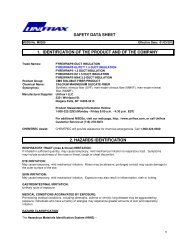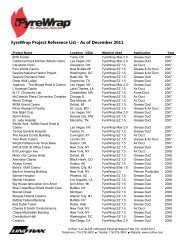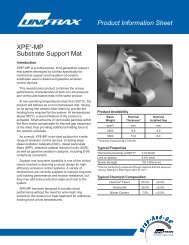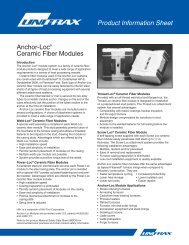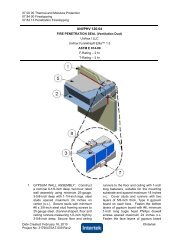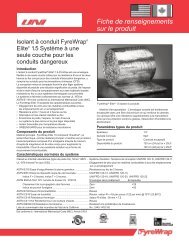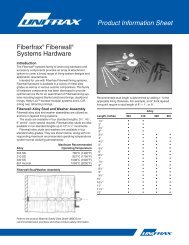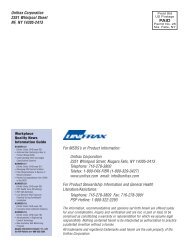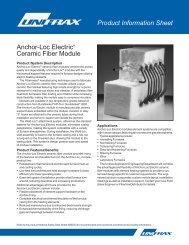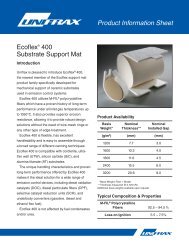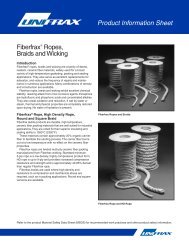TRADE NAMES: Fiberfrax Z,MX - Unifrax
TRADE NAMES: Fiberfrax Z,MX - Unifrax
TRADE NAMES: Fiberfrax Z,MX - Unifrax
You also want an ePaper? Increase the reach of your titles
YUMPU automatically turns print PDFs into web optimized ePapers that Google loves.
MATERIAL SAFETY DATA SHEET<br />
(EUROPEAN)<br />
MSDS NUMBER 500E Revision 19 According to 2001/58/EC<br />
DATE OF ISSUE 26 June 1998 DATE OF LAST REVISION : 24 th November 2009<br />
IDENTIFICATION OF THE SUBSTANCE<br />
1. IDENTIFICATION OF THE SUBSTANCE AND OF THE COMPANY<br />
<strong>TRADE</strong> <strong>NAMES</strong>: <strong>Fiberfrax</strong> Z,<strong>MX</strong> DENOMINATION:REFRACTORYCERAMIC<br />
FIBRES (RCF)<br />
FIBERFRAX Z products contain synthetic vitreous alumino-silicate fibres.<br />
IDENTIFICATION OF THE MANUFACTURER AND SALES CONTACTS<br />
GERMANY U.K<br />
<strong>Unifrax</strong> GmbH <strong>Unifrax</strong> Limited<br />
Postfach 16 01 62 Mill Lane, Rainford<br />
D-40564 Dusseldorf St Helens, Merseyside<br />
Germany WA11 8LP<br />
Tel: + 49 (0) 211) 87746 0 Tel: + 44 (0) 1744 88 7600<br />
Fax: + 49 (0) 211 87746 115 Fax: + 44 (0) 1744 88 9916<br />
France<br />
<strong>Unifrax</strong> France<br />
17 Rue Antoine Durafour<br />
42420 Lorette, France<br />
Tel.: +33(0)4-7773-7000<br />
Fax.:+33(0)4-7773-3991<br />
GERMANY Czech Republic<br />
<strong>Unifrax</strong> GmbH <strong>Unifrax</strong> s.r.o.<br />
Kleinreinsdorf 62 Novosedicka 125<br />
Teichwolframsdorf 07989 417 03<br />
Germany Dubi 3<br />
Tel: + 49 (0) 366-24-40020 Czech Republic<br />
Fax: + 49 (0) 366 24 400 99 Tel: + 42 (0) 417 800 356<br />
Fax: + 42 (0) 417 539<br />
SALES CONTACTS ONLY<br />
SPAIN ITALY<br />
<strong>Unifrax</strong> Spain <strong>Unifrax</strong> Italia Srl<br />
Cristobal Bordiu 20 Via Volonterio 19<br />
Madrid 28003 Saronno (Va) 21047<br />
Spain Italy<br />
Tel: + 34 91 395 2279 Tel: + 39 02 967 01 808<br />
Fax: + 34 91 395 2124 Fax: + 39 02 962 5721<br />
MSDS.500E Rev 19 Page 1 of 11<br />
Last Rev: 24 Nov 2009
Occupational Hygiene and CARE: Tel: + 44 (0) 1744 887603. Fax: + 44 (0) 1744 886173<br />
IRRITANT EFFECTS<br />
2. HAZARDS IDENTIFICATION<br />
Mild mechanical irritation to skin, eyes and upper respiratory system may result from exposure. These effects<br />
are usually temporary.<br />
CHRONIC RESPIRATORY HEALTH EFFECTS<br />
RCFs have been classified by the EU as a category 2 carcinogen (“substances which should be regarded as if<br />
they are carcinogenic to man”)<br />
The International Agency for Research on Cancer (IARC) reaffirmed that group 2B (“possibly carcinogenic to<br />
humans”) remains the appropriate classification for RCF.<br />
Pre-existing skin and respiratory conditions including dermatitis, asthma or chronic lung disease, might be<br />
aggravated by exposure<br />
3. COMPOSITION / INFORMATION OF INGREDIENTS<br />
COMPONENT EINECS NUMBER CAS NUMBER SYMBOL R PHRASES<br />
Alumino silicate fibres<br />
Zircon<br />
266-046-0<br />
239-019-6<br />
142 844 –00 –6<br />
14940-68-2<br />
MSDS.500E Rev 19 Page 2 of 11<br />
Last Rev: 24 Nov 2009<br />
T<br />
None<br />
None of the components are radioactive under the terms of the European Directive Eurotom 96/29<br />
COMPOSITION<br />
Chemical composition of <strong>Fiberfrax</strong> Z/<strong>MX</strong>: SiO2 50- 56% - Al2O3 28-35% - ZrO2 - 14-18%<br />
DESCRIPTION<br />
R49, R38<br />
None assigned<br />
FIBERFRAX Z/<strong>MX</strong> products are available in a variety of forms: bulks, blankets, papers, felts, boards, shapes,<br />
modules, cements, textiles (braids, ropes, cloth), coatings, mixes, mastics.<br />
Use of the product<br />
Restricted to “professional users” for application as thermal insulation, heat shields, heat containment, gaskets<br />
and expansion joints at temperatures up to 1400°C, (<strong>Fiberfrax</strong> Z) and 1450°C, (<strong>Fiberfrax</strong> <strong>MX</strong>) in industrial<br />
furnaces, ovens, kilns, boilers and other process equipment and in the aerospace, automotive and appliance<br />
industries, and as passive fire protection systems and firestops. Should not be sold directly to the general<br />
public, restricted to professional users.
SKIN<br />
4. FIRST AID MEASURES<br />
In case of skin irritation rinse affected areas with water and wash gently. Do not rub or scratch exposed skin.<br />
EYES<br />
In case of eye contact flush abundantly with water; have eye bath available. Do not rub eyes.<br />
NOSE AND THROAT:<br />
If these become irritated move to a dust free area, drink water and blow nose.<br />
If symptoms persist, seek medical advice.<br />
5. FIRE-FIGHTING MEASURES<br />
Non combustible products. Packaging and surrounding materials may be combustible.<br />
Use extinguishing agent suitable for surrounding combustible materials<br />
6. ACCIDENTAL RELEASE MEASURES<br />
Where abnormally high dust concentrations occur, provide workers with appropriate protective equipment as<br />
detailed in section 8.<br />
Restrict access to the area to a minimum number of workers required.<br />
Restore the situation to normal as quickly as possible.<br />
Prevent further dust dispersion for example by damping the materials.<br />
METHODS FOR CLEANING UP<br />
Pick up large pieces and use a vacuum cleaner fitted with high efficiency filter (HEPA)<br />
If brushing is used, ensure that the area is wetted down first.<br />
Do not use compressed air for clean-up.<br />
Do not allow to be wind blown.<br />
Do not flush spillage to drain and prevent from entering natural watercourses.<br />
Check for local regulations, which may apply.<br />
7. HANDLING AND STORAGE<br />
HANDLING / TECHNIQUES TO REDUCE DUST EMISSIONS DURING HANDLING<br />
HANDLING<br />
Handling can be a source of dust emission.<br />
Process should be designed to limit the amount of handling. Whenever possible, handling should be carried out<br />
under controlled conditions (i.e., use dust exhaust system).<br />
Using specially treated or packaged products will minimise dust release.<br />
Regular good housekeeping will minimise secondary dust dispersal.<br />
MSDS.500E Rev 19 Page 3 of 11<br />
Last Rev: 24 Nov 2009
STORAGE<br />
Store in original packaging in dry area whilst awaiting use<br />
Always use sealed and visibly labelled containers.<br />
Avoid damaging containers.<br />
Reduce dust emission during unpacking.<br />
Emptied containers, which may contain debris, should be cleaned before disposal or recycling.<br />
Recyclable cardboard and/or plastic films are recommended for packaging.<br />
HYGIENE STANDARDS AND CONTROL MEASURES<br />
8. EXPOSURE CONTROL / PERSONAL PROTECTION<br />
Hygiene standards and exposure limits may differ from country to country. Check those currently applying in<br />
your country and comply with local regulations.<br />
UK exposure limits in January 2007 are given below:<br />
United Kingdom 1.0 f/ml HSE EH40 Workplace Exposure Limit<br />
*8-hr time weighted average concentrations of airborne respirable fibres measured using the conventional<br />
membrane filter method<br />
ENGINEERING CONTROLS<br />
Review your RCF application(s) and assess situations with the potential for dust release.<br />
Where practical, enclose dust sources and provide dust extraction at source.<br />
Designate RCF work areas and restrict access to informed and trained workers.<br />
Use operating procedures, which will limit dust production and exposure of workers.<br />
Keep the workplace clean. Use a vacuum cleaner fitted with an HEPA filter; avoid using brooms and<br />
compressed air.<br />
If necessary, consult an industrial hygienist to design workplace controls and practices.<br />
Using products specially tailored to your application(s) will help to control dust. Some products can be delivered<br />
ready for use to avoid further cutting or machining. Some could be treated or packaged to minimise or avoid<br />
dust release during handling.<br />
Consult your supplier for further details<br />
PERSONAL PROTECTIVE EQUIPMENTS<br />
SKIN PROTECTION<br />
Wear gloves and work clothes, which are loose fitting at the neck and wrists. Soiled clothes should be cleaned<br />
to remove excess fibres before being taken off (e.g. use vacuum cleaner, not compressed air). Each worker<br />
should be provided with two lockers in an appropriate changing and washing area. It is good hygiene practice<br />
to ensure work clothes are washed separately by the employer. Work clothes should not be taken home.<br />
MSDS.500E Rev 19 Page 4 of 11<br />
Last Rev: 24 Nov 2009
EYE PROTECTION<br />
As necessary wear goggles or safety glass with side shields<br />
RESPIRATORY PROTECTION<br />
For dust concentrations below the exposure limit value, RPE is not required but FFP2 respirators may be used<br />
on a voluntary basis.<br />
For short term operations where excursions are less than ten times the limit value use FFP3 respirators.<br />
In case of higher concentrations or where the concentration is not known, please seek advice from your<br />
company and/or your supplier.<br />
You may also refer to the ECFIA code of practice available on the ECFIA’s web site<br />
INFORMATION AND TRAINING OF WORKERS<br />
This should include:<br />
The applications involving RCF-containing products ;<br />
The potential risk to health resulting from the exposure to fibrous dust ;<br />
The requirements regarding smoking, eating and drinking at the workplace ;<br />
The requirements for protective equipment and clothing.<br />
The good working practices to limit dust release ;<br />
The proper use of protective equipment.<br />
ENVIRONMENTAL EXPOSURE CONTROLS<br />
Refer to local, national or European applicable environmental standards for release to air, water and soil.<br />
For waste, refer to section13<br />
9. PHYSICAL AND CHEMICAL PROPERTIES<br />
Physical State Solid Melting point 1740°C<br />
Flammability None Length weighted geometric diameter 2-3µm<br />
Appearance White Explosive properties None<br />
Oxidising properties None Odour None<br />
10. STABILITY AND REACTIVITY<br />
CONDITIONS TO AVOID N.A. MATERIALS TO AVOID N.A.<br />
DECOMPOSITION PRODUCTS<br />
Upon heating above 900°C for sustained periods, this amorphous material begins to transform to mixtures of<br />
crystalline phases. For further information please refer to Section 16.<br />
11. TOXICOLOGICAL INFORMATION<br />
MSDS.500E Rev 19 Page 5 of 11<br />
Last Rev: 24 Nov 2009
HUMAN DATA<br />
IRRITANT PROPERTIES<br />
RCF is negative when tested using approved methods (Directive 67/548/EC, Annex 5, Method B4). All man<br />
made mineral fibres, like some natural fibres, can produce a mild irritation resulting in itching or rarely, in some<br />
sensitive individuals, in slight reddening. Unlike other irritant reactions this is not the result of allergy or chemical<br />
skin damage but is caused by a temporary mechanical effect.<br />
RESPIRATORY EFFECTS<br />
There is no known disease associated with exposure to RCF even though these fibres have been used for more<br />
than 40 years. Pulmonary morbidity studies were carried out among production workers in Europe and the USA.<br />
A statistically significant association between RCF exposure and pleural plaques was reported in the US<br />
morbidity study, this was not seen in Europe. Plaques do not develop into disease<br />
DATA FROM ANIMAL EXPERIMENTS<br />
In order to prepare samples for testing in animals RCF wools must be ground and suitably sized fibres<br />
separated. This process and its potential impact on the experimental findings have not been fully understood<br />
until quite recently. As such, in early animal experiments tumours were produced in animals after intrapleural<br />
and intraperitonal injections although inhalation experiments were inconclusive. A series of experiments were<br />
designed to overcome the shortcomings of these early attempts and in these, the so-called RCC studies, RCFs<br />
produced fibrosis, and a significant numbers of tumours including some mesotheliomas.<br />
However this was only at the highest exposures used. It is now known that, due to the method used to prepare<br />
the samples, these exposures included a large number of non-fibrous particles not typical of any human<br />
exposure and that the dose of particles and fibres achieved was sufficient to considerably reduce dust clearance<br />
from the lungs. This would now be regarded as exceeding the maximum tolerated dose and is a condition that,<br />
in animals, will result in lung inflammation and tumours.<br />
This would now indicate that the results might have depended more on the method of sample preparation than<br />
any material properties of the fibre tested.<br />
12. ECOLOGICAL INFORMATION<br />
These products are inert materials, which remain stable overtime.<br />
No adverse effects of this material on the environment are anticipated.<br />
13. DISPOSAL CONSIDERATIONS<br />
RCF is categorised as a stable none reactive hazardous waste, which can generally be disposed of at landfill,<br />
which has been licensed for this purpose. Please refer to the European list (Decision no 2000/532/CE as<br />
modified) to identify your appropriate waste number, and insure national and or regional regulation are complied<br />
with. Taking into account any possible contamination during use, expert guidance should be sought.<br />
Unless wetted, such a waste is normally dusty and so should be properly sealed in clearly labelled containers for<br />
disposal. At some authorised disposal sites, dusty waste may be treated differently in order to ensure they are<br />
dealt with promptly to avoid them being wind blown. Check for national and/or regional regulations, which may<br />
apply<br />
.<br />
14. TRANSPORT INFORMATION<br />
MSDS.500E Rev 19 Page 6 of 11<br />
Last Rev: 24 Nov 2009
Not classified as dangerous goods under relevant international transport regulations (ADR, RID, IATA, IMDG<br />
Refer Section 16 “Definitions”).<br />
Ensure that dust is not wind blown during transportation.<br />
Fibre type definition according to Directive 67/548/EEC<br />
15. REGULATORY INFORMATION<br />
Regulatory status in the EU, comes from European Directive 67/548/EEC, on the classification, labelling and<br />
packaging of dangerous substances and preparations as modified by Directive 97/69/EEC and its<br />
implementations by the Member States.<br />
According to Directive 67/548/EEC, the fibre contained in this product belongs to the group of “man made<br />
vitreous(silicate) fibres with random orientation with alkaline oxide and alkali earth oxide ( Na2O<br />
+K2O+CaO+MgO+BaO) content less or equal to 18% by weight”.<br />
Fibre type classification for substances and preparations according to annex I to Directive 67/548/EEC<br />
Classification: Carcinogen Category 2 : Irritant<br />
SYMBOL T ( Skull and Crossbones -Toxic)<br />
RISK PHRASES<br />
R49 May cause cancer by inhalation<br />
R38 Irritating to skin<br />
SAFETY ADVICE PHRASES<br />
S24/25 Avoid contact with skin and eyes<br />
S36/37/39 Wear suitable loose fitting, long-sleeved clothing, gloves and eye protection<br />
S38 Wear suitable respiratory equipment<br />
Marketing and use of RCF is controlled by Directive 76/769/EEC and is restricted to professional use only.<br />
The toxic label as detailed will be applied to bulk fibres , dry preparations, fibre blanket, boards and modules<br />
encapsulated only on 4 sides as required under Directive 67/548/EC, all other products will be labelled with an<br />
attention label.<br />
.<br />
This applies for sales in the European Union<br />
PROTECTION OF WORKERS<br />
Shall be in accordance with several European Directives as amended and their implementations by the Member<br />
States:<br />
Council Directive 89/391/EEC dated 12 June 1989 “on the introduction of measures to encourage<br />
improvement in the safety and health of workers at work (OJEC (Official Journal of the European Community) L<br />
183 of 29 June 1989,p.1).<br />
Council Directive 98/24/EC dated 7 April 1997 “ on the protection of workers from the risks related to chemical<br />
agents at work” (OJEC L 131 of 5 May 1998,p.11).<br />
Council Directive 90/394/EC of 28 June 1990 on the protection of workers from risks related to exposure to<br />
MSDS.500E Rev 19 Page 7 of 11<br />
Last Rev: 24 Nov 2009
carcinogens at work (OJEC L 196 of 26 July 1990,p.1).<br />
Member states are in charge of implementing European directives into their own national regulation within a<br />
period of time normally given in the directive. Member States may impose more stringent requirements. Please<br />
always refer to national regulations.<br />
16. OTHER INFORMATION<br />
USEFUL REFERENCES (the directives which are sited<br />
must be considered in their amended version)<br />
Working with Refractory Ceramic Fibres ; ECFIA Code of Practice (February 1998)<br />
Recognition and control of exposure to Refractory Ceramic Fibres (RCF) ; ECFIA Industrial hygiene guide<br />
(November 1999)<br />
Hazard from the use of Refractory Ceramic Fibres. Health and Safety Executive ; Information document HSE<br />
267 (1998)- UK<br />
Council Directive 89/391/EEC dated 12 June 1989 “on the introduction of measures to encourage improvements<br />
in the safety and health of workers at work” (OJEC L 183 of 29 June 1989,p.1)<br />
Council Directive 67/548/EEC on the “approximation of the laws, regulations and administrative provision<br />
relating to the classification, packaging and labelling of dangerous substances as modified and adapted to the<br />
technical progress” (OJEC L 196 of 16 August 1967,p.1 and its modifications and adaptations to technical<br />
progress).<br />
Commission Directive 97/69/EC of 5 December 1997 “adapting to technical progress for the 23 rd time Council<br />
Directive 67/548/EEC ,( OJEC L 343 Official Journal of the European Communities, 13/12/97 , p.19).<br />
Council Directive 90/394/EC “on the protection of workers from risks related to exposure to carcinogens at work”<br />
Official journal of the European Communities, 26/07/90<br />
Council Directive 98/24/EC of 7 th April 1998 “on the protection of the health and safety of workers from risks<br />
related to chemical agents at work” (OJEC L131 of 5 th May 1998, P.11)<br />
TRGS 521 : Faserstaube 5/2002 - Germany<br />
TRGS 619 – Germany<br />
TRGS 905 –3/01<br />
Maxime LD et al (1998), CARE – A European pro-gramme for monitoring and reducing refractory ceramic fibres<br />
dust at the workplace Initial results. Gefahrstoffe – Reinhaltung der Luft, 58-3, 97-103.<br />
Refractory ceramic fibres : a substitute study, RCFC document, March 1996.<br />
Circulaire DRT No 954 du 12/01/95- France<br />
Circolare 15 marzo 2000, n.4 – Italy<br />
The zircon used in this product contains small amounts of uranium and thorium, which are naturally occurring,<br />
radioactive materials (NORMs). However none of the components are radioactive under the terms of the<br />
European Directive Euratom 96/29.<br />
DEFINITIONS<br />
ADR – Transport by road, council directive 94/55/EC<br />
IMDG – Regulations relating to transport by sea<br />
RID – Transport by rail, Council Directive 96/49/EC<br />
ICAO/IATA - Regulations relating to transport by air<br />
Precautionary measures to be taken after service and upon removal<br />
As produced, all RCF fibres are vitreous (glassy) materials which, if raised up to continued exposure to elevated<br />
temperatures (above 900°C) might de-vitrify. The occurrence and extent of crystalline phase formation is<br />
dependent on the duration and temperature of exposure, fibre chemistry and/or the presence of fluxing agents.<br />
The presence of crystalline phases can be confirmed only through laboratory analysis of the “hot-face” fibre.<br />
MSDS.500E Rev 19 Page 8 of 11<br />
Last Rev: 24 Nov 2009
Simulated after-service RCF, containing 27% of crystalline silica showed little, or no, activity where exposure<br />
was by inhalation or by intraperitoneal injection. After service RCF was not cytotoxic to macrophage-like cells.<br />
High concentrations of fibres and other dusts may be generated when after-service products are mechanically<br />
disturbed during operations such as wrecking. These dusts may contain crystalline silica, which some authorities<br />
have classified as a carcinogen. Therefore ECFIA recommends:<br />
• control measures are taken to reduce dust emissions.<br />
• all personnel directly involved wear an appropriate respirator to minimise exposure and comply with local<br />
regulatory limits.<br />
These procedures will ensure compliance with local regulatory exposure standards for free crystalline silica. And<br />
because de-vitrified fibres containing silica mixed with amorphous and other crystalline phases are far less<br />
biologically active than free crystalline silica dusts, these measures will provide a high degree of protection.<br />
CARE PROGRAMME<br />
The European Ceramic Fibres Industry Association (ECFIA) has undertaken an extensive industrial hygiene<br />
programme to provide assistance to the users of RCF products.<br />
The objectives are twofold:<br />
• to monitor workplace dust concentrations at both manufacturers’ and customers’ premises,<br />
• to document manufacturing and use of RCF products from an industrial hygiene perspective in order to<br />
establish appropriate recommendations to reduce exposures.<br />
If you wish to participate in the CARE programme, contact ECFIA or you supplier.<br />
SPRAYING<br />
ECFIA recommends that this fibre is not used for spraying<br />
NOTE<br />
The directives and subsequent regulations detailed in this Material Safety Data Sheet are only applicable to the<br />
European Union (EU) Countries and not to countries outside of the EU.<br />
Websites<br />
The European Ceramic Fibres Industry Association (ECFIA) : 3, Rue du Colonel Moll, 75017 Paris<br />
Tel. +33 (0)1 44 05 54 84 - Fax +33 (0)1 44 05 54 94<br />
Site Web : www.ecfia.org<br />
Or to Deutsche Keramikfaser-Gesellschaft e.V. web site: www.dkfg.de<br />
MSDS.500E Rev 19 Page 9 of 11<br />
Last Rev: 24 Nov 2009
NOTICE:<br />
The information presented here in is based on data considered to be accurate as of the date of preparation of<br />
this Material Safety Data Sheet. However, no warranty or representation, express or implied, is made as to the<br />
accuracy or completeness of the foregoing data and safety information, nor is any authorisation given or implied<br />
to practice any patented invention without a licence. In addition, no responsibility can be assumed by the vendor<br />
for any damage or injury resulting from abnormal use, from any failure to adhere to recommended practices, or<br />
from any hazards inherent in the nature of the product.<br />
OTHER SIGNIFICANT ADDITIVES<br />
PRODUCTS Significant Ingredients (%<br />
by weight)<br />
Hazard<br />
warning<br />
Risk Phrase<br />
MSDS.500E Rev 19 Page 10 of 11<br />
Last Rev: 24 Nov 2009
Lubricated bulk<br />
Non-lubricated bulk<br />
Blankets<br />
Durablanket Z<br />
Papers and Felts<br />
Durafelt Z<br />
Papers and Felts<br />
Durafelt 1500<br />
Mastics<br />
Pyrocoat<br />
Boards and Shapes<br />
Duraboard 140 LD, Rigiform Z,.<br />
Sibral Super Vacuum formed<br />
Boards<br />
Boards and Shapes<br />
,<br />
Duraboard 140 ZK<br />
Boards and Shapes<br />
Rigiform 1500,<br />
Boards and Shapes<br />
Flexiform 1500<br />
<strong>Fiberfrax</strong> Prismo-Block S<br />
Prismo block Z , Prismo-block <strong>MX</strong><br />
Bonded Modules<br />
Bonded-Z, Bonded-<strong>MX</strong><br />
Bonded Modules<br />
Bonded - 1500<br />
Organic lubricant<br />
(< 1%)<br />
None assigned None assigned<br />
None None None<br />
None None None<br />
Acrylic latex (< 15%) None None<br />
Acrylic latex (< 15%) None None<br />
Alumina ( 30-35%)<br />
Sodium silicate ( 15-18%)<br />
Amorphous Silica<br />
(


